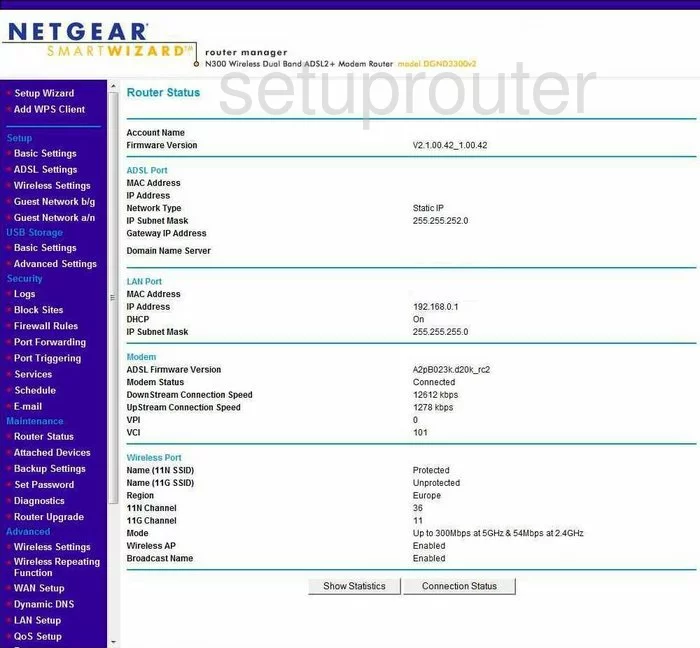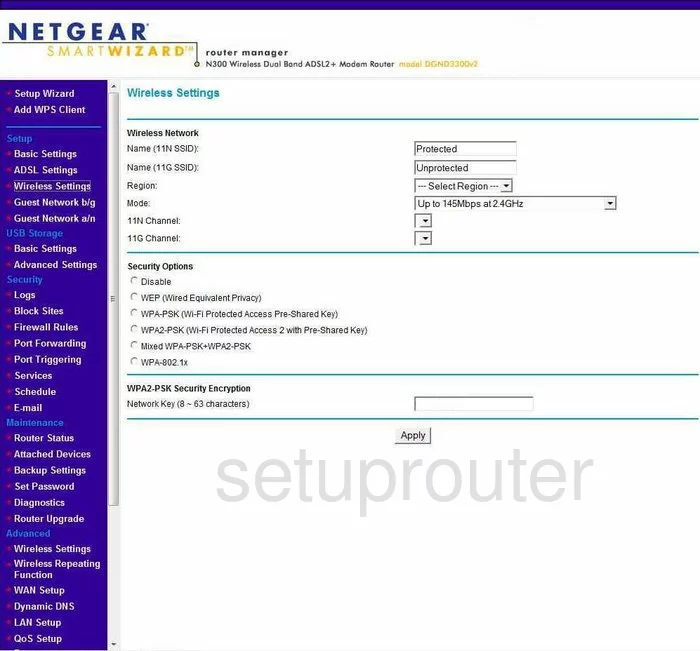The Netgear DGND3300 router is considered a wireless router because it offers WiFi connectivity. WiFi, or simply wireless, allows you to connect various devices to your router, such as wireless printers, smart televisions, and WiFi enabled smartphones.
Other Netgear DGND3300 Guides
This is the wifi guide for the Netgear DGND3300 v2. We also have the following guides for the same router:
- Netgear DGND3300 v2 - Reset the Netgear DGND3300
- Netgear DGND3300 v2 - How to change the IP Address on a Netgear DGND3300 router
- Netgear DGND3300 v2 - Netgear DGND3300 User Manual
- Netgear DGND3300 v2 - Netgear DGND3300 Login Instructions
- Netgear DGND3300 v2 - How to change the DNS settings on a Netgear DGND3300 router
- Netgear DGND3300 v2 - Information About the Netgear DGND3300 Router
- Netgear DGND3300 v2 - Netgear DGND3300 Screenshots
WiFi Terms
Before we get started there is a little bit of background info that you should be familiar with.
Wireless Name
Your wireless network needs to have a name to uniquely identify it from other wireless networks. If you are not sure what this means we have a guide explaining what a wireless name is that you can read for more information.
Wireless Password
An important part of securing your wireless network is choosing a strong password.
Wireless Channel
Picking a WiFi channel is not always a simple task. Be sure to read about WiFi channels before making the choice.
Encryption
You should almost definitely pick WPA2 for your networks encryption. If you are unsure, be sure to read our WEP vs WPA guide first.
Login To The Netgear DGND3300
To get started configuring the Netgear DGND3300 WiFi settings you need to login to your router. If you are already logged in you can skip this step.
To login to the Netgear DGND3300, follow our Netgear DGND3300 Login Guide.
Find the WiFi Settings on the Netgear DGND3300
If you followed our login guide above then you should see this screen.

After you have logged into the Netgear DGND3300v2 you start on the Home page.
Go to the left sidebar and click the option of Wireless Settings under Setup.
Change the WiFi Settings on the Netgear DGND3300

You should now be on the page you see above.
In the first section titled Wireless Network:
- Name(11N SSID) - This is the name for your network ID. Only enter a name here if all your wireless devices are newer than 2009 which means they are 802.11N compatible. Please note that older 802.11G devices will not be able to connect to this network.
- Name(11G SSID) - Enter a wireless name here if you have older wireless devices or are unsure of the devices ages. It's usually fine to use 802.11G. This ensures the highest level of compatibility but will not be as fast as an 802.11N network. To learn more check out this guide. You can put a different network name in each box and have both networks at the same time if you like.
- Region - Select the region in which you live using this drop down list.
- Mode - If you chose to enter a name in 11N SSID only then you need to choose the option of UP to 145Mbps at 2.4GHz or Up to 300Mbps at 2.4Ghz. If you chose only to enter a name in both boxes you will need to choose either Up to 145Mbps at 5GHz and 54Mbps at 2.4GHz or the mode of Up to 300Mbps at 5GHz and 54Mbps at 2.4GHz
- 11N or 11G Channel - Enter an appropriate channel here. We recommend choosing 2.4GHz channels of 1,6, or 11. Find out why in this guide.
The next section is titled Security Options:
- WPA2-PSK (Wi-Fi Protected Access 2 with Pre-Shared Key) - We strongly recommend choosing this security option as it is the strongest security available right now. Learn all about it in our WPA2 guide.
The last section is called the WPA2-PSK Security Encryption:
- Network Key (8 ~ 63 characters) - This is the last setting that needs to be changed. This is the network password and should be at least 14 characters in length. We have lots of great ideas for you in this Password Guide.
That's it, just click the Apply button before you exit to finalize your changes.
Possible Problems when Changing your WiFi Settings
After making these changes to your router you will almost definitely have to reconnect any previously connected devices. This is usually done at the device itself and not at your computer.
Other Netgear DGND3300 Info
Don't forget about our other Netgear DGND3300 info that you might be interested in.
This is the wifi guide for the Netgear DGND3300 v2. We also have the following guides for the same router:
- Netgear DGND3300 v2 - Reset the Netgear DGND3300
- Netgear DGND3300 v2 - How to change the IP Address on a Netgear DGND3300 router
- Netgear DGND3300 v2 - Netgear DGND3300 User Manual
- Netgear DGND3300 v2 - Netgear DGND3300 Login Instructions
- Netgear DGND3300 v2 - How to change the DNS settings on a Netgear DGND3300 router
- Netgear DGND3300 v2 - Information About the Netgear DGND3300 Router
- Netgear DGND3300 v2 - Netgear DGND3300 Screenshots